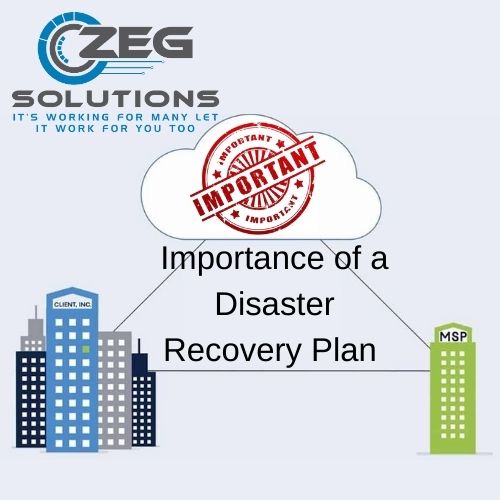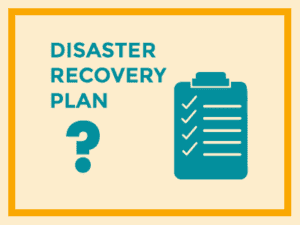The Importance of a Disaster Recovery Plan
 Any business whether large or small can face natural or operational disasters that cripple its operations significantly. Whether you get up afterward is largely a function of how well prepared you were.
Any business whether large or small can face natural or operational disasters that cripple its operations significantly. Whether you get up afterward is largely a function of how well prepared you were.
Statistics compiled by FEMA show that 40% of disasters fail due to disasters. Even worse, 25% of those that do recover fail within a year. To ensure that your business can rise from the ashes successfully in case of a disaster, you first need to protect it with a disaster recovery plan.
In broad terms, a disaster recovery plan is part of a Business Continuity Plan which spells out how you can ensure the continuity of your business in the face of disruptions. A major component of this is an IT Disaster Recovery Plan or IT DRP.
What is a Disaster Recovery Plan (DRP)
A DRP is a structured, step-by-step document that dictates how your team responds to unforeseen catastrophic disruptions so as to resume normal operations as quickly as possible.
For some businesses, a DRP is mandatory. For example, in the health sector, overseeing bodies require every business to have one.
Even if it may not be legally required to have one, it is a good business practice to prepare for the worst. Here is how you can protect your business with a disaster recovery plan.
How to Protect Your Business With Disaster Recovery
The actual process of disaster recovery can take many forms depending on the industry. However, it all stems from having a solid DRP.
1. Conduct a Business Impact Analysis (BIA)

A Business Impact Analysis is a prediction of what effects a disaster would have on the business at varying levels of intensity. It takes into account the possible impact on finances, assets, human resources, customers or clients, safety, contracts, among others.
In the BIA, consider what implications disruption of the business would have on your staff. How would customers react? What would be your bottom line if operations were to cease at once?
The BIA is the foundation upon which predictive countermeasures can be put in place. It is the heart of the entire DRP and ultimately determines how successful the disaster recovery would be if it were implemented.
Take special consideration regarding how the disruption of your IT infrastructure would impact your business. This is best done in conjunction with IT experts to more accurately gauge expected consequences.
If you’re not sure how to go about that, Zeg Solutions based in Houston, Texas is your go-to expert partner. The team consists of IT professionals with decades of experience in IT infrastructure and data backup. Together, we can plan on how best to protect your precious business.
2. Come up With Recovery Plan 
The BIA guides you on what recovery countermeasures need to be implemented. Through extensive consultation with stakeholders and experts, you can prepare countermeasures against the more common disasters that affect businesses today.
There are several components to recovery planning, whose extent you can decide upon.
- Safety – You need to plan for the safety of your staff. In case of disasters like fires, you need to have access to emergency response. The safety of your team will be your immediate concern, so have the contacts of emergency responders prominently recorded.
- Data Recovery -No business can afford total data wipeout. What would happen if you lost financial data, contracts, or customer data? You need to have viable options such as offsite storage or better still, cloud backup. Have a plan on how you can restore your data within hours of facing disaster.
- Relocation to a new site – Fires, floods, storms, earthquakes, among other unprecedented catastrophes can make your current location inhabitable. Have a plan on how you can relocate your core systems to a secondary location as fast as possible.
- Restoration of Core Systems- In case of disruption to your IT infrastructure, how will you restore core functionality to keep your business going? Contact an IT Solutions expert near you to plan on how you can achieve that.
- Communication with Customers – In the wake of disruption to your business operations, it is crucial to keep your customers informed. This ensures that you can continue to do business with them in the future. Have a plan on how you can get in touch with all your customers and clients to maintain your business relationship.
3. Communicate the Plans, Update Conduct Drills Often
Once you have your plan in place, make sure you share it with key personnel. Everyone involved in it should know exactly what to do in every scenario envisioned. Provide training in all areas concerned.
You need to keep your disaster recovery plan recent. It is good practice to review it yearly and update it accordingly. As your business grows, so should your DRP. You should also conduct regular drills to keep everyone on their toes.
Benefits of Implementing Disaster Recovery
Disaster doesn’t have to be a death blow to your company. Some of the more common ones like IT failures or fires are no more than a hiccup if you can implement disaster recovery procedures efficiently.
Besides helping you get back on your feet, disaster recovery has many other benefits.
- Protect yourself against loss of data – Data protection and recovery is at the heart of every disaster recovery plan. By maintaining up to date backups, you can restore it in case of loss or corruption.
- Maintain productivity – Every minute your team spends idle translates to revenue loss. Having a disaster recovery plan ensures that even in times of severe disruptions, everyone can keep working to keep your business going.
- Protect your reputation – You don’t want to lose your customers, clients or partners in the event that your business operations are interrupted. It is easy to lose their confidence if every time you face a problem, it takes days to recover. Disaster recovery helps keep your reputation intact.
- It is part of compliance regulations – Many laws both federal and state mandate that businesses have disaster recovery plans be put in place.
Disaster recovery is crucial for any business. When coming up with recovery procedures, you need to have experts in the loop to advise you and help implement the plans effectively.
IT Disaster Recovery lies at the core of your recovery plans. Zeg Solutions in Houston, Texas is an IT solutions company with over 20 years of experience in IT recovery. Contact the team today to learn how you can protect your business from failure in case of disaster.
Please contact us to learn more:
Phone: 713-903-3271
Email: [email protected]





